Hyundai Elantra 2018 Workshop Manual
Manufacturer: HYUNDAI, Model Year: 2018, Model line: Elantra, Model: Hyundai Elantra 2018Pages: 526, PDF Size: 17.2 MB
Page 51 of 526
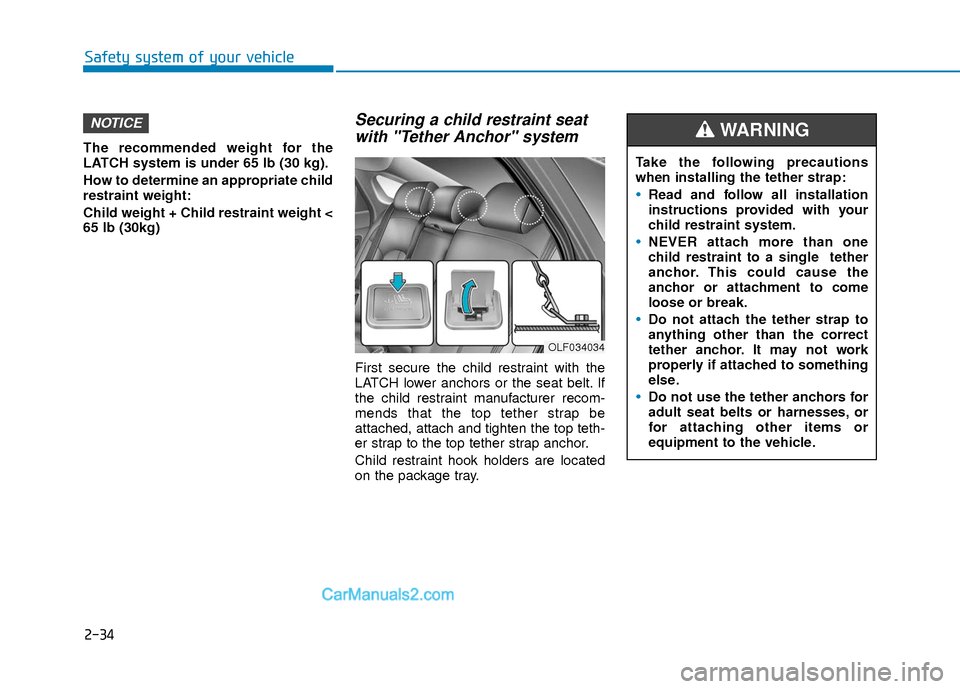
2-34
Safety system of your vehicle
The recommended weight for the
LATCH system is under 65 lb (30 kg).
How to determine an appropriate child
restraint weight:
Child weight + Child restraint weight <
65 lb (30kg)
Securing a child restraint seatwith "Tether Anchor" system
First secure the child restraint with the
LATCH lower anchors or the seat belt. If
the child restraint manufacturer recom-
mends that the top tether strap be
attached, attach and tighten the top teth-
er strap to the top tether strap anchor.
Child restraint hook holders are located
on the package tray.
NOTICE
OLF034034
Take the following precautions
when installing the tether strap:
Read and follow all installation
instructions provided with your
child restraint system.
NEVER attach more than one
child restraint to a single tether
anchor. This could cause the
anchor or attachment to come
loose or break.
Do not attach the tether strap to
anything other than the correct
tether anchor. It may not work
properly if attached to something
else.
Do not use the tether anchors for
adult seat belts or harnesses, or
for attaching other items or
equipment to the vehicle.
WARNING
Page 52 of 526
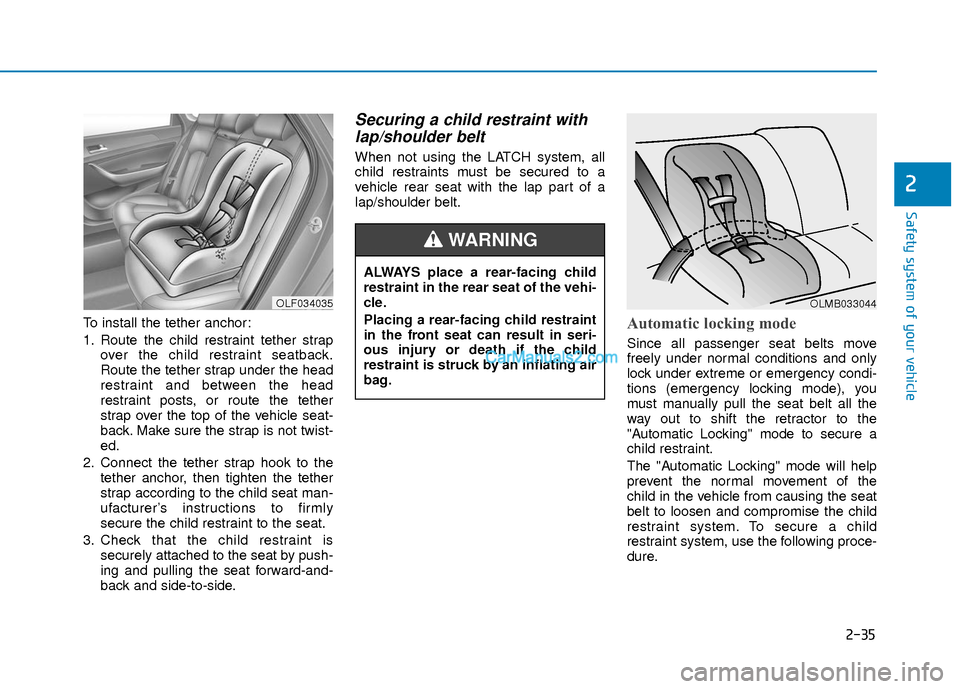
2-35
Safety system of your vehicle
2
To install the tether anchor:
1. Route the child restraint tether strapover the child restraint seatback.
Route the tether strap under the head
restraint and between the head
restraint posts, or route the tether
strap over the top of the vehicle seat-
back. Make sure the strap is not twist-
ed.
2. Connect the tether strap hook to the tether anchor, then tighten the tether
strap according to the child seat man-
ufacturer’s instructions to firmly
secure the child restraint to the seat.
3. Check that the child restraint is securely attached to the seat by push-
ing and pulling the seat forward-and-
back and side-to-side.
Securing a child restraint withlap/shoulder belt
When not using the LATCH system, all
child restraints must be secured to a
vehicle rear seat with the lap part of a
lap/shoulder belt.
Automatic locking mode
Since all passenger seat belts move
freely under normal conditions and only
lock under extreme or emergency condi-
tions (emergency locking mode), you
must manually pull the seat belt all the
way out to shift the retractor to the
"Automatic Locking" mode to secure a
child restraint.
The "Automatic Locking" mode will help
prevent the normal movement of the
child in the vehicle from causing the seat
belt to loosen and compromise the child
restraint system. To secure a child
restraint system, use the following proce-
dure.
OLF034035
ALWAYS place a rear-facing child
restraint in the rear seat of the vehi-
cle.
Placing a rear-facing child restraint
in the front seat can result in seri-
ous injury or death if the child
restraint is struck by an inflating air
bag.
WARNING
OLMB033044
Page 53 of 526
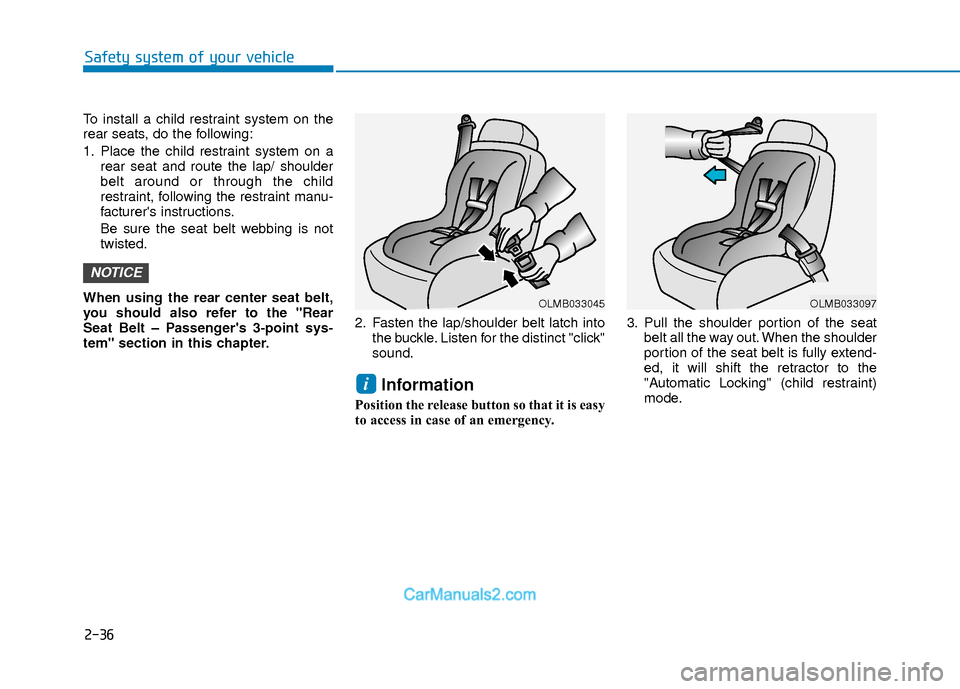
2-36
Safety system of your vehicle
To install a child restraint system on the
rear seats, do the following:
1. Place the child restraint system on arear seat and route the lap/ shoulder
belt around or through the child
restraint, following the restraint manu-
facturer's instructions.
Be sure the seat belt webbing is not
twisted.
When using the rear center seat belt,
you should also refer to the "Rear
Seat Belt – Passenger's 3-point sys-
tem" section in this chapter. 2. Fasten the lap/shoulder belt latch into
the buckle. Listen for the distinct "click"
sound.
Information
Position the release button so that it is easy
to access in case of an emergency. 3. Pull the shoulder portion of the seat
belt all the way out. When the shoulder
portion of the seat belt is fully extend-
ed, it will shift the retractor to the
"Automatic Locking" (child restraint)
mode.
i
NOTICE
OLMB033045OLMB033097
Page 54 of 526
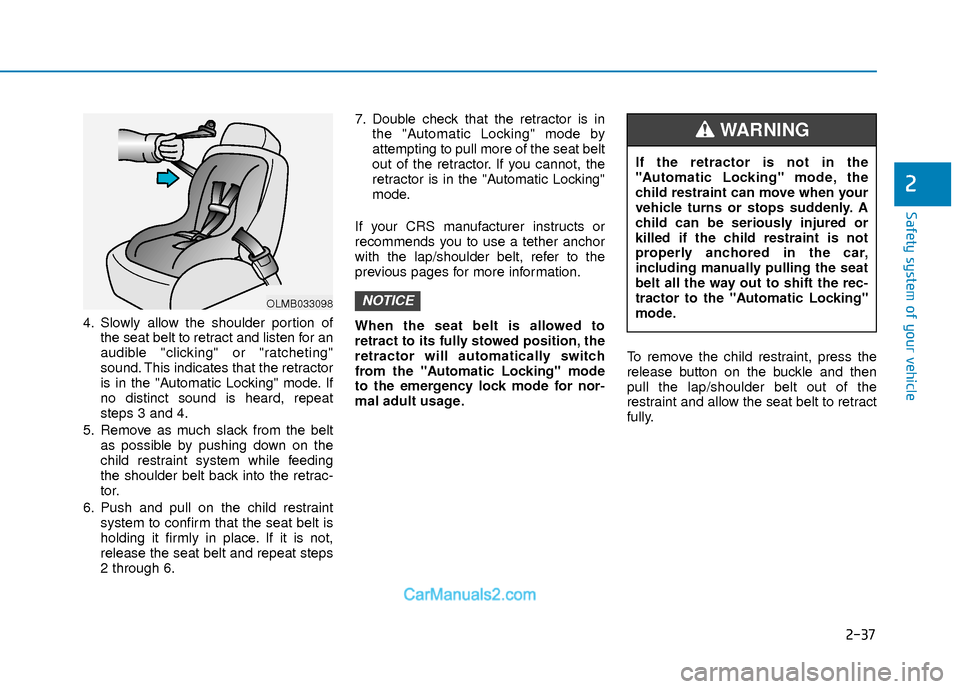
2-37
Safety system of your vehicle
2
4. Slowly allow the shoulder portion ofthe seat belt to retract and listen for an
audible "clicking" or "ratcheting"
sound. This indicates that the retractor
is in the "Automatic Locking" mode. If
no distinct sound is heard, repeat
steps 3 and 4.
5. Remove as much slack from the belt as possible by pushing down on the
child restraint system while feeding
the shoulder belt back into the retrac-
tor.
6. Push and pull on the child restraint system to confirm that the seat belt is
holding it firmly in place. If it is not,
release the seat belt and repeat steps
2 through 6. 7. Double check that the retractor is in
the "Automatic Locking" mode by
attempting to pull more of the seat belt
out of the retractor. If you cannot, the
retractor is in the "Automatic Locking"
mode.
If your CRS manufacturer instructs or
recommends you to use a tether anchor
with the lap/shoulder belt, refer to the
previous pages for more information.
When the seat belt is allowed to
retract to its fully stowed position, the
retractor will automatically switch
from the "Automatic Locking" mode
to the emergency lock mode for nor-
mal adult usage. To remove the child restraint, press the
release button on the buckle and then
pull the lap/shoulder belt out of the
restraint and allow the seat belt to retract
fully.
NOTICEOLMB033098
If the retractor is not in the
"Automatic Locking" mode, the
child restraint can move when your
vehicle turns or stops suddenly. A
child can be seriously injured or
killed if the child restraint is not
properly anchored in the car,
including manually pulling the seat
belt all the way out to shift the rec-
tractor to the "Automatic Locking"
mode.
WARNING
Page 55 of 526
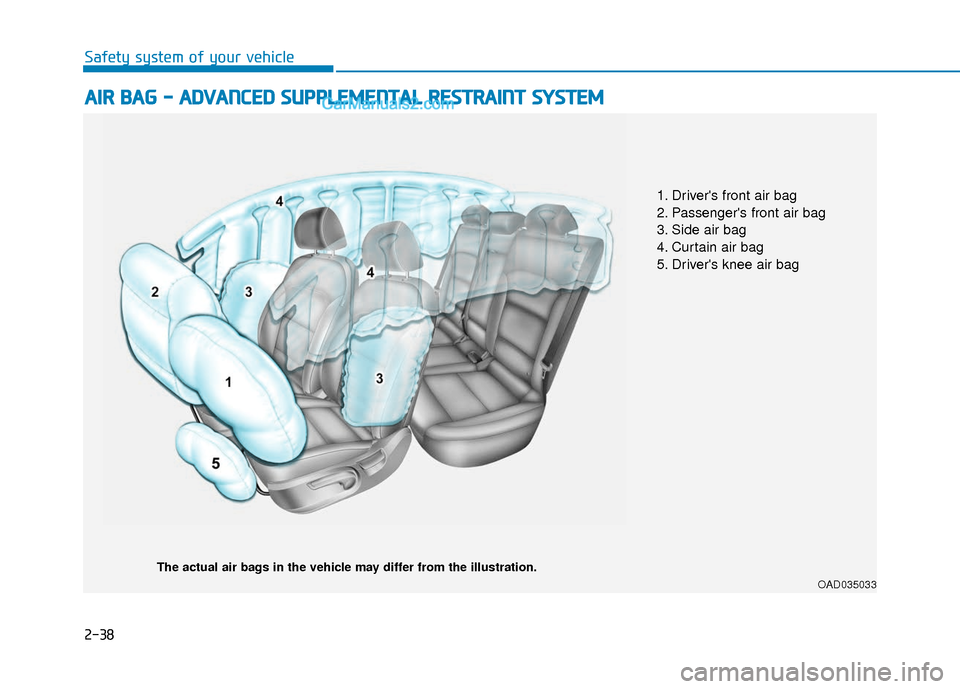
2-38
Safety system of your vehicle
A
AI
IR
R
B
B A
A G
G
-
-
A
A D
DV
VA
A N
N C
CE
E D
D
S
S U
U P
PP
PL
LE
E M
M E
EN
N T
TA
A L
L
R
R E
ES
ST
T R
R A
A I
IN
N T
T
S
S Y
Y S
ST
T E
EM
M
OAD035033
The actual air bags in the vehicle may differ from the illustration.
1. Driver's front air bag
2. Passenger's front air bag
3. Side air bag
4. Curtain air bag
5. Driver's knee air bag
Page 56 of 526
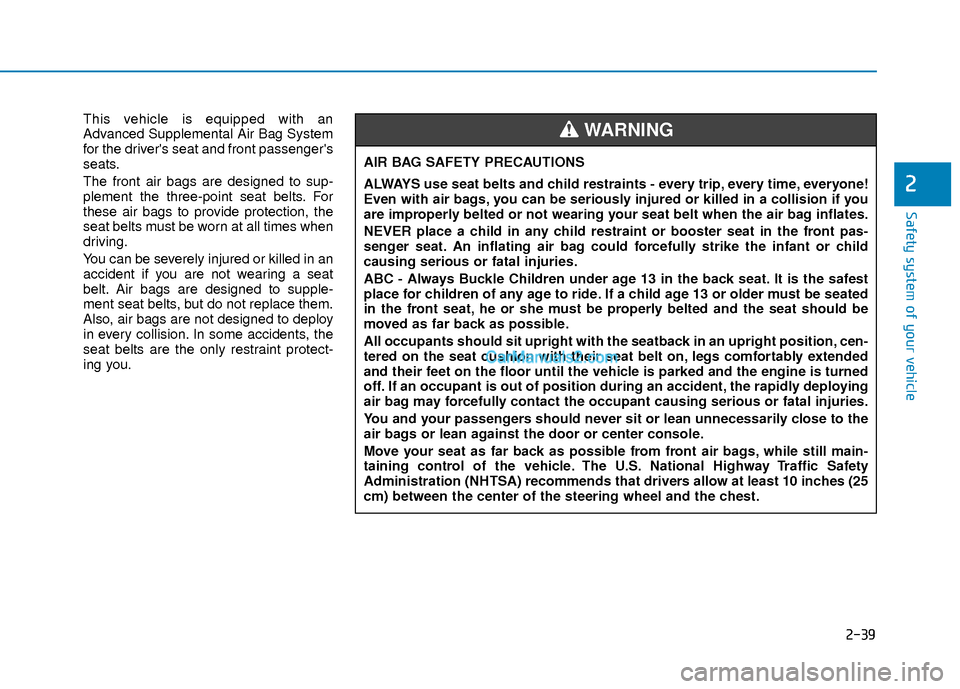
2-39
Safety system of your vehicle
2
This vehicle is equipped with an
Advanced Supplemental Air Bag System
for the driver's seat and front passenger's
seats.
The front air bags are designed to sup-
plement the three-point seat belts. For
these air bags to provide protection, the
seat belts must be worn at all times when
driving.
You can be severely injured or killed in an
accident if you are not wearing a seat
belt. Air bags are designed to supple-
ment seat belts, but do not replace them.
Also, air bags are not designed to deploy
in every collision. In some accidents, the
seat belts are the only restraint protect-
ing you.AIR BAG SAFETY PRECAUTIONS
ALWAYS use seat belts and child restraints - every trip, every time, everyone!
Even with air bags, you can be seriously injured or killed in a collision if you
are improperly belted or not wearing your seat belt when the air bag inflates.
NEVER place a child in any child restraint or booster seat in the front pas-
senger seat. An inflating air bag could forcefully strike the infant or child
causing serious or fatal injuries.
ABC - Always Buckle Children under age 13 in the back seat. It is the safest
place for children of any age to ride. If a child age 13 or older must be seated
in the front seat, he or she must be properly belted and the seat should be
moved as far back as possible.
All occupants should sit upright with the seatback in an upright position, cen-
tered on the seat cushion with their seat belt on, legs comfortably extended
and their feet on the floor until the vehicle is parked and the engine is turned
off. If an occupant is out of position during an accident, the rapidly deploying
air bag may forcefully contact the occupant causing serious or fatal injuries.
You and your passengers should never sit or lean unnecessarily close to the
air bags or lean against the door or center console.
Move your seat as far back as possible from front air bags, while still main-
taining control of the vehicle. The U.S. National Highway Traffic Safety
Administration (NHTSA) recommends that drivers allow at least 10 inches (25
cm) between the center of the steering wheel and the chest.WARNING
Page 57 of 526

2-40
Safety system of your vehicle
Where Are the Air Bags?
Driver's and passenger's frontair bags
Your vehicle is equipped with a
Advanced Supplemental Restraint
System (SRS) and lap/shoulder belts at
both the driver and passenger seating
positions.
The SRS consists of air bags which are
located in the center of the steering
wheel, in the driver's side lower crash
pad below the steering wheel column
and the passenger's side front panel pad
above the glove box.
The air bags are labeled with the letters
"AIR BAG" embossed on the pad covers. The purpose of the SRS is to provide the
vehicle's driver and front passengers
with additional protection than that
offered by the seat belt system alone.
The SRS uses sensors to gather infor-
mation about the driver’s and front pas-
senger's seat belt usage and impact
severity.
The seat belt buckle sensors determine if
the driver and front passenger's seat
belts are fastened. These sensors pro-
vide the ability to control the SRS deploy-
ment based on whether or not the seat
belts are fastened, and how severe the
impact is.
The advanced SRS offers the ability to
control the air bag inflation within two lev-
els. A first stage level is provided for mod-
erate-severity impacts. A second stage
level is provided for more severe impacts.
According to the impact severity, and
seat belt usage, the SRS Control Module
(SRSCM) controls the air bag inflation.
Failure to properly wear seat belts can
increase the risk or severity of injury in
an accident.
OAD035034
OAD035035
OAD035039
■Driver's knee air bag
■Driver's front air bag
■Passenger's front air bag
Page 58 of 526
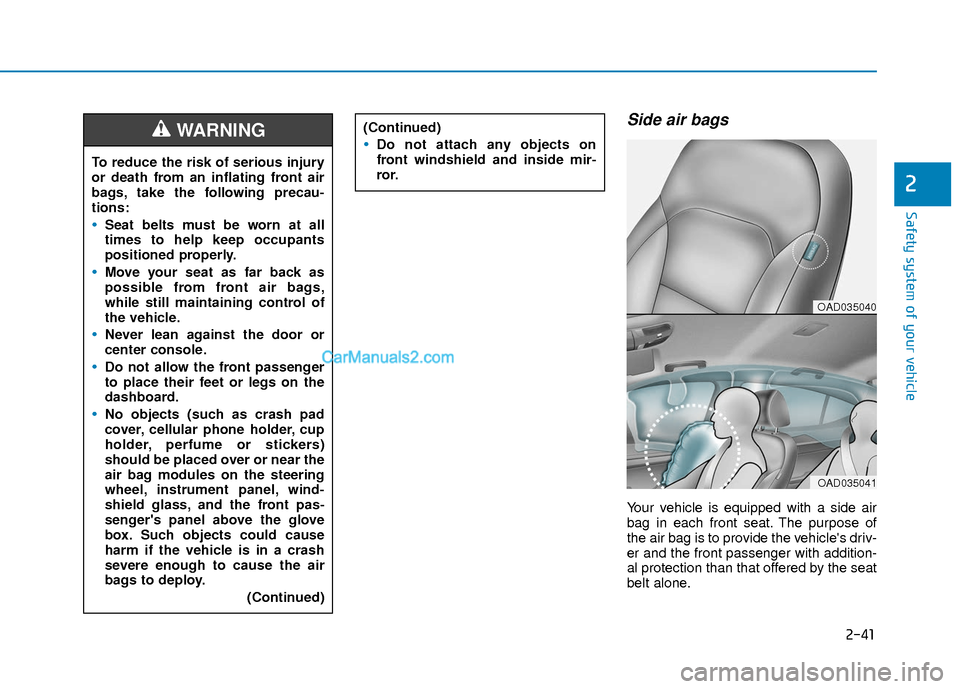
2-41
Safety system of your vehicle
2
Side air bags
Your vehicle is equipped with a side air
bag in each front seat. The purpose of
the air bag is to provide the vehicle's driv-
er and the front passenger with addition-
al protection than that offered by the seat
belt alone.
To reduce the risk of serious injury
or death from an inflating front air
bags, take the following precau-
tions:
Seat belts must be worn at all
times to help keep occupants
positioned properly.
Move your seat as far back as
possible from front air bags,
while still maintaining control of
the vehicle.
Never lean against the door or
center console.
Do not allow the front passenger
to place their feet or legs on the
dashboard.
No objects (such as crash pad
cover, cellular phone holder, cup
holder, perfume or stickers)
should be placed over or near the
air bag modules on the steering
wheel, instrument panel, wind-
shield glass, and the front pas-
senger's panel above the glove
box. Such objects could cause
harm if the vehicle is in a crash
severe enough to cause the air
bags to deploy.
(Continued)
(Continued)
Do not attach any objects on
front windshield and inside mir-
ror.WARNING
OAD035040
OAD035041
Page 59 of 526
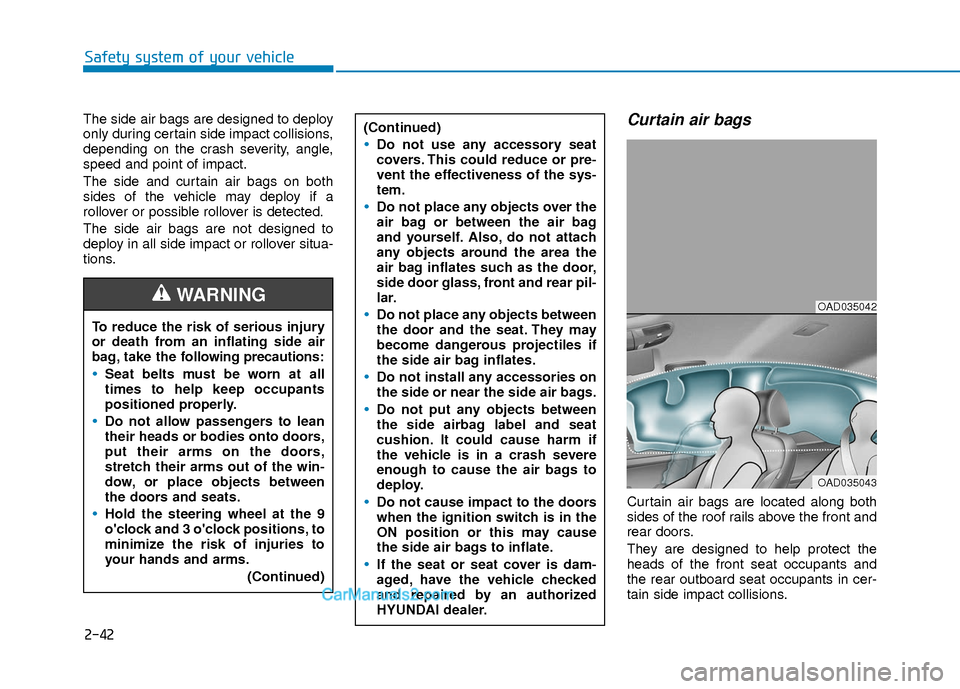
2-42
Safety system of your vehicle
The side air bags are designed to deploy
only during certain side impact collisions,
depending on the crash severity, angle,
speed and point of impact.
The side and curtain air bags on both
sides of the vehicle may deploy if a
rollover or possible rollover is detected.
The side air bags are not designed to
deploy in all side impact or rollover situa-
tions.Curtain air bags
Curtain air bags are located along both
sides of the roof rails above the front and
rear doors.
They are designed to help protect the
heads of the front seat occupants and
the rear outboard seat occupants in cer-
tain side impact collisions.
(Continued)
Do not use any accessory seat
covers. This could reduce or pre-
vent the effectiveness of the sys-
tem.
Do not place any objects over the
air bag or between the air bag
and yourself. Also, do not attach
any objects around the area the
air bag inflates such as the door,
side door glass, front and rear pil-
lar.
Do not place any objects between
the door and the seat. They may
become dangerous projectiles if
the side air bag inflates.
Do not install any accessories on
the side or near the side air bags.
Do not put any objects between
the side airbag label and seat
cushion. It could cause harm if
the vehicle is in a crash severe
enough to cause the air bags to
deploy.
Do not cause impact to the doors
when the ignition switch is in the
ON position or this may cause
the side air bags to inflate.
If the seat or seat cover is dam-
aged, have the vehicle checked
and repaired by an authorized
HYUNDAI dealer.
To reduce the risk of serious injury
or death from an inflating side air
bag, take the follo
wing precautions:
Seat belts must be worn at all
times to help keep occupants
positioned properly.
Do not allow passengers to lean
their heads or bodies onto doors,
put their arms on the doors,
stretch their arms out of the win-
dow, or place objects between
the doors and seats.
Hold the steering wheel at the 9
o'clock and 3 o'clock positions, to
minimize the risk of injuries to
your hands and arms.
(Continued)
WARNING OAD035042
OAD035043
Page 60 of 526
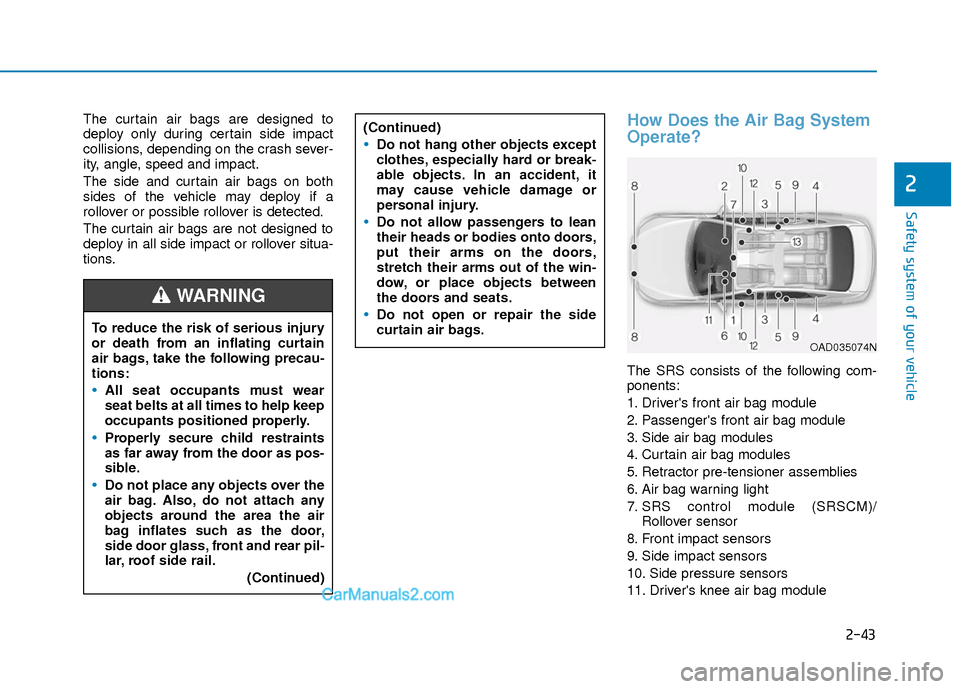
2-43
Safety system of your vehicle
2
The curtain air bags are designed to
deploy only during certain side impact
collisions, depending on the crash sever-
ity, angle, speed and impact.
The side and curtain air bags on both
sides of the vehicle may deploy if a
rollover or possible rollover is detected.
The curtain air bags are not designed to
deploy in all side impact or rollover situa-
tions.How Does the Air Bag System
Operate?
The SRS consists of the following com-
ponents:
1. Driver's front air bag module
2. Passenger's front air bag module
3. Side air bag modules
4. Curtain air bag modules
5. Retractor pre-tensioner assemblies
6. Air bag warning light
7. SRS control module (SRSCM)/Rollover sensor
8. Front impact sensors
9. Side impact sensors
10. Side pressure sensors
11. Driver's knee air bag module
To reduce the risk of serious injury
or death from an inflating curtain
air bags, take the following precau-
tions:
All seat occupants must wear
seat belts at all times to help keep
occupants positioned properly.
Properly secure child restraints
as far away from the door as pos-
sible.
Do not place any objects over the
air bag. Also, do not attach any
objects around the area the air
bag inflates such as the door,
side door glass, front and rear pil-
lar, roof side rail.
(Continued)
(Continued)
Do not hang other objects except
clothes, especially hard or break-
able objects. In an accident, it
may cause vehicle damage or
personal injury.
Do not allow passengers to lean
their heads or bodies onto doors,
put their arms on the doors,
stretch their arms out of the win-
dow, or place objects between
the doors and seats.
Do not open or repair the side
curtain air bags.
WARNING
OAD035074N